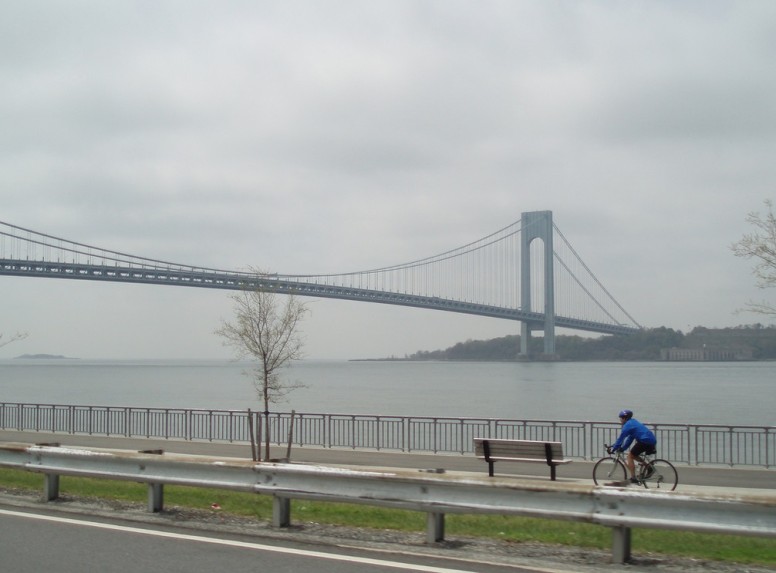All 12 of the lanes on the Verrazano-Narrows Bridge are designated for the exclusive use of cars, trucks and buses. Except during the New York City Marathon and the 5 Boro Bike Tour, there is no way to get across if you’re not in a motorized vehicle. That may soon change.
The MTA announced earlier this month that it is studying the addition of pedestrian and bicycle accommodations on the 51-year-old suspension bridge which links Brooklyn and Staten Island. The proposals being studied include:
- adding a pair of cantilevered structures to the sides of the bridge on the lower level, one of which would support a two-way bicycle path, and a pedestrian path on the other
- adding a similar set of cantilevered structures to the sides of the bridge on the upper level, which would require even longer (and more expensive) access ramps
- building an entirely new pedestrian and bicycle bridge between Brooklyn and Staten Island independent of the Verrazano Narrows Bridge
These proposals would cost an estimated $300-$400 million, a price tag Staten Island electeds have called “daunting” and “difficult to justify.” Even New York Assemblymember (and avid bike rider) Nicole Malliotakis believes “there is still a long way to go before this can be seriously considered.”
One proposal that the MTA will not pursue is building pedestrian and bicycle paths on the bridge’s upper level between the suspender cables. A 1997 study by Amman & Whitney (the firm that designed the Verrazano and the George Washington Bridge, among others) recommended this option. But the MTA has said such a project would be a non-starter, not only because of security concerns, but also because the path wouldn’t be wide enough to meet today’s standards.
There’s another way to accommodate pedestrians and people on bikes that the MTA hasn’t yet studied: converting a traffic lane into a multi-use path.
Converting one of the 12 existing lanes into a shared pedestrian and bicycle path would reduce motor vehicle capacity by 8.3 percent. While re-purposing a lane for bicyclists and pedestrians might not sound like a great idea to those who drive over the bridge during rush hour, consider this: average daily traffic on the Verrazano isn’t growing. In fact, ADT fell from about 206,000 in 2003 to 192,000 in 2013. That’s a 7 percent drop.
Also consider the fact that the MTA is adding a bus/HOV lane to the upper deck of the Verrazano (while maintaining six general purpose lanes) to accommodate the demand for better transit options across the bridge. This would have to be modeled, but the combined congestion-mitigating benefits of a bus/HOV lane and pedestrian and bicycle access just might be enough to offset the impact of losing one of the 12 general traffic lanes.
Traffic headed east from Staten Island to Brooklyn accounted for about 52 percent of total traffic in 2013, with the other 48 percent of vehicles headed west from Brooklyn to Staten Island, so it would make sense to remove a vehicular travel lane from the westbound side. (Bonus: a lane on the westbound side would have spectacular views of New York Harbor, the Manhattan skyline and the Statue of Liberty.) The bike path could be separated from traffic in the same way the new Pulaski Bridge bike path is being separated, and a raised sidewalk could be built to match the height of the existing narrow sidewalk.
We used Streetmix to figure out what converting a general purpose lane to a bike and pedestrian path might look like:


Re-purposing an existing lane of vehicular traffic to accommodate people walking and biking is sure to raise the ire of drivers. But, with a 7 percent drop in ADT and the addition of a bus/HOV lane, it is worth studying the idea. While this may not be the most politically expedient option, it is the most cost effective. And, as we’ve seen in this region, worthy projects have been scrapped due to cost. This could be the way to ensure those walking and biking across the Verrazano get the priority they deserve without the threat of probative costs dooming the project.


I’m sure the price is less than 1 percent of the money spent building and maintaining this bridge. The bridge created one and only one way to get to SI from Brooklyn: drive. We cannot wonder why we have so much traffic on SI. We designed it that way.
A path on the roadway (where traffic is going 60+ miles per hour) is going to be loud and inhospitable for walkers and cyclists, who travel at human speeds and are not enclosed in sound buffering boxes. The Triboro bridge has a great view but when the walking/riding path gets close to the roadway it’s not pleasant. We need something to attract people not something people will only tolerate to avoid paying a toll.
Residents of SI and Brooklyn deserve to have a pleasant path with fantastic views that encourage them to walk, cycle, and visit their neighboring borough and spend some money.
This is a great idea. Simplest and cheapest.
Build a beautiful path and put the toll up by a $ to pay for it. Infrastructure is for all and all must pay.
Interesting idea. It could be tested by using a flexible barrier system to create a bike/ped lane during off-peak travel times.
An environmental factor that needs to be kept in mind for any kind of non-motorized path in that area is the extreme bursts of wind that come off of New York harbor.
It’s not simple and not cheap. It’s a lot of money and even if it’s allocated, which I doubt, it will be applied in time to other needs as was the 2nd Avenue Bond funds. Ultimately, it will be bargain away for overruns or for the crisis-of-that-week.
A mammoth waste of money.